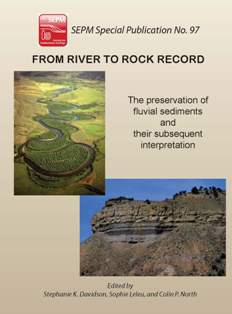How To Propose a Book Publication
Special Publications Proposals

The Society for Sedimentary Geology SEPM invites your proposals for the SEPM Special Publication series, the procedures for which are outlined below.
SEPM publishes
- Special Publication Series (red book) - variety of topics, result of symposia, conferences, meetings (usually multiple authors and volume editors and stand alone chapters)
- Concepts in Sedimentology and Paleontology - undergraduate or post-graduate text books or state-of-the-art (usually single or small number of authors)
- Atlas Series - compilations of maps, sedimentary structures, petrographic and diagenetic features, facies, etc.
- Field Trip Guides
- Miscellaneous Publications - formats that don't fit above categories
Who to approach with a proposal
SEPM will consider proposals that investigate any and all aspects of sedimentary geology, in particular topics that are of current interest to the geoscience community. We encourage you to peruse the list of Special Publications (https://www.sepm.org/Special-Publications) to get a sense of where the subject matter of your proposal lies with respect to publication history.
Once your ideas have been formulated you can send them to the Special Publications Editor ( Special Publications Editor , or any member of the SEPM Council (SEPM Council).
What to include in a proposal
- Indicate the kind of publication you intend, for example, will the publication be part of the (traditional) red book series with contributions from several authors, contributions from a core conference, or an Atlas or a more text book like Concepts.
- An outline of the intended subject matter and its relevance to the geoscience community. If the publication is to be an outcome of a research conference or other technical meeting, what other sponsor organizations are involved? What is the range of topics being sought? Who are the confirmed or potential contributors to the publication?
- Who will be the lead volume editor/author; other editors/authors?
- Who is the intended audience for the publication?
- What time-lines do you anticipate for author contributions, reviews, and revision, through to the final publication?
- Is there additional funding to help defray the publication costs (an absence of additional funds does not preclude approval)
The approval process
The SP Editor will review, and frequently will seek external advice from experts to ensure fair treatment of all proposals.
When approval has been given, the SEPM SP Editor will become the main point of contact with the volume editor(s). The primary role of the SEPM Editor is outlined below. The SEPM Editor's role at this stage is to keep track of the publication, via the PeerTrack system, as it progresses through manuscript submission, the review process, manuscript acceptance/rejection, and technical editing. The SEPM Editor can also assist the Volume Editors at any stage of the publication process when necessary.
SEPM is determined to reduce the SP publication time to acceptable levels. To do this, Volume Editors will need to ensure that both volume contributors and reviewers adhere as closely as possible to time lines defined at the beginning of the project. In this, the SEPM Editor can assist, particularly at the 'arm-twisting' stage of manuscript review and author revision; the Editor is mindful of the delays that have haunted some Special Publication projects and are determined to avoid such delays in the future.
All SEPM Special Publications now progress through the (digital) PeerTrack system. Volume Editors will have access to submitted digital manuscripts, and will be able to direct and monitor the progress of the volume contributions from submission, through the review and revision process, to acceptance/rejection, and the final technical editing stage.





